This post is the second in a series on the origin and history of HeLa S3 cells. The first post can be found here. In this post, we discuss the life and careers (yes, careers) of the remarkable physician-scientist, Florence Rena Sabin.
"Too bad you're not a boy, you would have made a good doctor."
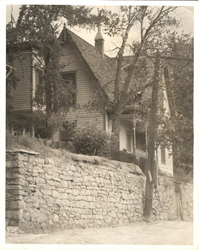 Florence Rena Sabin was born in the mining town of Central City, Colorado, on November 9, 1871, two years after her sister and lifelong companion, Mary. Florence's father. George Sabin, had moved from Vermont to Colorado in the midst of the Colorado gold rush and a notable 1859 gold strike between the towns of Central City and Black Hawk. Her mother, Serena (Rena) Miner (yes, Miner), was a Vermont school teacher in Savannah, Georgia who moved sight unseen to Black Hawk to respond to an ad for a schoolteacher. (This photograph of their home, like many in this post, are derived from The Florence R. Sabin Papers, freely available from the National Library of Medicine's Profiles in Science Collection.)
Florence Rena Sabin was born in the mining town of Central City, Colorado, on November 9, 1871, two years after her sister and lifelong companion, Mary. Florence's father. George Sabin, had moved from Vermont to Colorado in the midst of the Colorado gold rush and a notable 1859 gold strike between the towns of Central City and Black Hawk. Her mother, Serena (Rena) Miner (yes, Miner), was a Vermont school teacher in Savannah, Georgia who moved sight unseen to Black Hawk to respond to an ad for a schoolteacher. (This photograph of their home, like many in this post, are derived from The Florence R. Sabin Papers, freely available from the National Library of Medicine's Profiles in Science Collection.)
If you've driven I-70 from Denver International Airport to any number of Colorado ski areas, you have passed a highway specifically built to bring you to these two former mining towns for a different kind of gold: limited stakes casino gambling.
Tough, hardscrabble living in the mountains led the family to move to Denver while Mr. Sabin continued to work in the mining business. Sadly, the girls' mother died in childbirth in 1878 and George Sabin enrolled his daughters in a boarding school called Wolfe Hall, where both would later teach. Mr. Sabin recognized how deeply the girls were devastated by the loss of their mother and his long absences didn't help matters. The girls were sent to live with their uncle Albert in Chicago - though not the Albert Sabin of poliovirus vaccine fame. He brought them to visit and then ultimately live with their paternal grandparents in Saxtons River, Vermont.
I belabor this issue because it was then that Florence's grandmother remarked that one of their ancestors, Levi Sabin, had been a doctor and her father had attended medical school for two years before moving to seek his fortune in gold. Observing Florence's love of nature and biology, her grandmother remarked, "Too bad you're not a boy, you would have made a good doctor."
Florence apparently took this statement as a challenge, vowing to become a doctor anyway. She finished school in Vermont and attended Smith College where she was befriended by the school physician, Dr. Grace Preston. Preston took an interest in Florence, cultivating her interest in biology and chemistry and advising her about a new university in Baltimore whose medical school would be accepting women owing in part to an unusual turn of events.
Money talks: how wise women influenced a new medical school
Founder of that eponymous university, philanthropist Johns Hopkins, had counted on income from B&O; Railroad stock to establish the medical school and recruit faculty. (N.B., the peculiar extra S was because his first name was actually a family surname - source.) However, the 1890s were economically volatile times and Hopkins only had funds to open the hospital but not the medical school. As documented in the history of the university, four daughters of the university's original trustees offered to help, with conditions:
Martha Carey Thomas, Mary Elizabeth Garrett, Elizabeth King and Mary Gwinn, all unmarried, wealthy, well-educated and devoted to the new feminist movement - offered a deal. They would raise the $500,000 needed to open the school and pay for a medical school building, but only if the school would open its doors to qualified women. Arguments ensued, the pragmatists won out, and the women were given the go-ahead to try.When the money was in hand by Christmas Eve, 1892, the Women's Fund Committee added a strategic twist, making new demands that even the staunchest opponents of a coeducational school could not reasonably refuse. Garrett - who as daughter of the head of the B&O; was able to donate about $350,000 to the effort herself - presented a list of stiff entrance requirements that would have to be met by any Hopkins applicant, male or female: proof of a bachelor's degree, proficiency in French, German and Latin, and a strong background in physics, chemistry and biology. Hopkins' leaders were taken aback; most of the demands appeared to have been lifted directly from an early letter by [first professor and dean, William Henry] Welch to University President Gilman - suggestions that even Welch, after he hired on, admitted he thought were impossible goals.
Yes, medical school standards varied widely at the time and these "impossible goals" pushed forward by the women established the new institution as one of the best in the United States.
To understand the prevailing attitude toward women in higher education, the following were the 1874 comments of Gilman's colleague Charles Eliot, president of Harvard University, who called coeducation "a thoroughly wrong idea which is rapidly disappearing," Hopkins trustees had Gilman call upon Eliot as a consultant on this issue:
"[S]tudents might fall in love, which could produce disastrous, socially unequal marriages; women would have trouble keeping up with the academic pace and hold up instruction for the men; the stress could prove so severe that the women might fall ill and destroy their chances of good marriages; and finally, a woman's future was so different from a man's that there was no point in educating them together."
 Unfortunately, George Sabin's mining company in Denver was also suffering financially for many of the same reasons that the Hopkins railroad investments delayed opening of the medical school. The 1890s were volatile economic times not to be matched until The Great Depression. As such, Florence could not afford to attend medical school after graduating from Smith College in 1893 (her senior picture is shown to the left) and would have to assume financial responsibility for any future education.
Unfortunately, George Sabin's mining company in Denver was also suffering financially for many of the same reasons that the Hopkins railroad investments delayed opening of the medical school. The 1890s were volatile economic times not to be matched until The Great Depression. As such, Florence could not afford to attend medical school after graduating from Smith College in 1893 (her senior picture is shown to the left) and would have to assume financial responsibility for any future education.
As a result, Sabin came back to Denver to teach at Wolfe Hall, where her sister Mary was already working since her own graduation from Smith two years earlier. In 1895, Florence returned to Smith to teach and then received a fellowship during the summer of 1896 to work at the renowned Marine Biological Laboratories at Woods Hole on Cape Cod.
With these experiences and now-sufficient savings, Sabin was able to apply and be accepted to Johns Hopkins Medical School for the 1896-97 academic year. Exemplifying the commitment of Hopkins to training female physicians, Florence was one of 14 women in a class of 45.
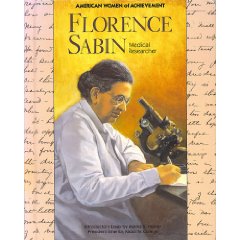 What follows from her remarkable career is detailed at numerous sites on the web including a 1960 National Academies Press biography, the National Library of Medicine, and the Rockefeller Archive Center. But I detail these early life influences here because they are not widely accessible outside of archives at Smith College and the Colorado Historical Society and are covered only briefly in the 1960 National Academies biography. I learned most of the preceding story from a remarkable out-of-print 1990 book from a 50-book series entitled, American Women of Achievement. Written by New York freelance writer, Janet Kronstadt, this 101-page volume on Sabin can be purchased used on Amazon for only a few dollars, roughly the same cost as shipping.
What follows from her remarkable career is detailed at numerous sites on the web including a 1960 National Academies Press biography, the National Library of Medicine, and the Rockefeller Archive Center. But I detail these early life influences here because they are not widely accessible outside of archives at Smith College and the Colorado Historical Society and are covered only briefly in the 1960 National Academies biography. I learned most of the preceding story from a remarkable out-of-print 1990 book from a 50-book series entitled, American Women of Achievement. Written by New York freelance writer, Janet Kronstadt, this 101-page volume on Sabin can be purchased used on Amazon for only a few dollars, roughly the same cost as shipping.
The book and websites above chronicle the rest of Sabin's remarkable life of medical achievement and public service but I'll provide some of the highlights as follows.
A career of "firsts"
At Johns Hopkins, Sabin worked with anatomist Franklin Paine Mall and published in 1901, the year after her graduation, An Atlas of the Medulla and Midbrain, that served as an neuroanatomy text for the next three decades (see here at Google Books). Her 1900-01 internship with famed physician Sir William Osler is credited with planting the seed of her interest in tuberculosis that came back to serve her in the laboratory in the 20s and 30s and in public health in the 40s.
In 1903, Sabin became the first woman faculty member at the Johns Hopkins School of Medicine and was noted for her work on the origin and development of the lymphatic system. Her 1913 book arguing that lymphatics derive from the venous system and not tissues spaces is probably the most complete compilation of the nine critical publications documenting her early work, also accessible here at Google Books. In 1917, she was appointed Professor of Histology, the first woman full professor at Johns Hopkins and in 1924 became the first woman president of the American Association of Anatomists.
But when Mall died in 1917, Sabin was passed over as head of the anatomy department in favor of her own former student, Dr. Lewis Weed. She continued in her work but, not surprisingly, was ripe for recruitment to Rockefeller Institute for Medical Research by Dr. Simon Flexner, the original director of Rockefeller and elder brother of Alexander Flexner. (Discussed here in a 2006 NEJM review, Alexander Flexner's 1910 report defined the standards of American and Canadian medical schools for the rest of the 20th century.)
In joining Rockefeller as a full member, a full professor equivalent, Sabin was the first woman to hold such a position at that institution as well. Her work had turned to the immune system's response to the bacillus that causes tuberculosis, monocytes in particular, and how fibrotic "tubercles" develop and contribute to the destruction of surrounding tissue. In April, 1925, Sabin became the first woman elected to the National Academy of Sciences. This link will take you to a PDF of her notification letter from The Florence Rena Sabin Papers.
Accounts of her time at Rockefeller indicate that she was a tireless mentor of young investigators, men and women, and life in New York City fed her diverse interests in theatre and music. This 1941 version of her personal bookplate reflects her literary interests, work ethic, and love for science. Her National Academy biography notes this comment from a co-worker at the time:
"The great joy and pleasure which she derived from her work were like a contagion among those around her so that all were stimulated in much the same manner that she was. I have never known any other person to be quite so buoyed up by intellectual stimuli as she was. Dr. Sabin was one of those people who, however strenuous the previous day might have been, waked at the crack of dawn with great enthusiasm for what the day was to hold. She was nearly always the first one at the laboratory, and greeted every one with a joie de vivre which started the day pleasantly for all of us. . . . Despite the fact that she was the first to arrive in the morning, she was often the last to leave in the evening."
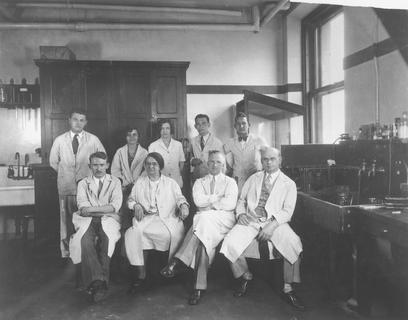 Photos: Above: Dr. Sabin with her Rockefeller laboratory group in 1930; Below: At her scope, The Rockefeller Archives
Photos: Above: Dr. Sabin with her Rockefeller laboratory group in 1930; Below: At her scope, The Rockefeller Archives
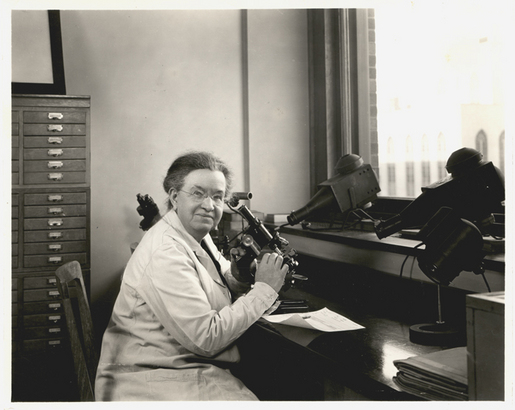
"Retirement" on the Health Committee of Colorado's Post-War Planning Committee
When she retired from Rockefeller in 1938, the signature book for her retirement reception (here) reflected the deep admiration her students and colleagues felt for her, including a pre-World War II version of a smiley emoticon from Thomas Rivlin and the inscription, "All blood cells love you and wish you many more happy years." Other inscriptions include, "with ten years of memories that are with each succeeding year more deeply significant, " and another that noted her work in the women's suffrage movement: "with appreciation and admiration of the National Women's Party."
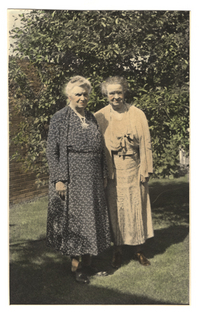 At age 67, Dr. Sabin returned to Denver to live with her sister, Mary, living another career in "retirement." This photo with Mary on the left was taken in 1939, shortly after Florence returned to Denver. (For those of you who know Denver, Florence and Mary lived in the Stanley Arms apartments at 1321-1333 E 10th Ave, just west of Cheesman Park and the Denver Botanic Gardens)
At age 67, Dr. Sabin returned to Denver to live with her sister, Mary, living another career in "retirement." This photo with Mary on the left was taken in 1939, shortly after Florence returned to Denver. (For those of you who know Denver, Florence and Mary lived in the Stanley Arms apartments at 1321-1333 E 10th Ave, just west of Cheesman Park and the Denver Botanic Gardens)
After living in Baltimore and New York City and working at the nation's top medical centers, Sabin was appalled at the state of public health in her native Colorado. As World War II drew to a close, she was tapped by Gov. John Vivian (and then under the next governor) to lead a group examining health services in anticipation of the needs of returning soldiers. A PDF of the letter of invitation can be viewed here.
She traveled to all 63 Colorado counties and lobbied politicians to gain passage in 1947 of four of six proposed "Sabin Bills" to improve preventative health and facilities for existing tuberculosis patients, general sanitation, and an overhaul of the state's Board of Health. She then served on the board of what is now Denver General Hospital and then the Denver Department of Health.
As an example of her impact, Sabin's encouragement of chest X-ray screening resulted in a 50% reduction in the death rate from tuberculosis in Denver within two years. The incidence of syphilis dropped by 90% during the same time period (from 700 to 60 cases per 100,000). In 1951, Sabin received a Lasker Award, not for her laboratory career but instead for her work in public health.
Sabin turned 80 on November 9, 1951, just one month after a woman named Henrietta Lacks had died of cervical cancer at the hospital where she had been a professor. On December 1, the University of Colorado School of Medicine honored Dr. Sabin on this milestone with the formal dedication of the Florence R. Sabin Building for Research in Cellular Biology, the site where the black tobacco farmer and medical research would become intertwined.
On October 3, 1953, Sabin died of a heart attack while recovering from pneumonia at her Denver apartment. Her biography notes that she died while watching her beloved Brooklyn Dodgers on television in the World Series. I find it noteworthy that today a handwritten letter from Dr. Sabin goes for $1,800 whereas a photo signed by 11 members of the 1953 Dodgers can be had for $375.
The story of Florence Rena Sabin is still recognized and examined in pockets of the academy as evidenced by this 2009 article in Gender Forum, an internet journal for gender studies. Entitled. "The Quiet Feminism of Dr. Florence Sabin: Helping Women Achieve in Science and Medicine," by Dr. Patricia J.F. Rosof of St. Francis College, this detailed and painstakingly referenced historical perspective documents Sabin's semi-stealth activism in women's rights extending back to her 1900 graduation from Johns Hopkins Medical School.
A statue of Sabin at her microscope was presented in 1959 as the first of Colorado's representatives in The National Statuary Hall Collection at the U.S. Capitol. Each state is granted only two statues to honor the persons most notable in their history. The other Colorado statuary representative is that of the Apollo 13 astronaut, John L. "Jack" Swigert, Jr., the Denver native who was portrayed by Kevin Bacon in the movie, Apollo 13.
Back to the story of HeLa S3
At the time of Dr. Sabin's death, a physician-scientist named Theodore "Ted" Puck was working on cellular genetics in his University of Colorado School of Medicine laboratory in the building carrying Sabin's name. Recruited to Colorado in 1948 as the founding chair of the Department of Biophysics, Puck played a major role in the application of bacterial culture methodologies to assessing the growth requirements of human cells in culture.
On page 100 of Rebecca Skloot's book, The Immortal Life of Henrietta Lacks, she makes a very brief reference to the role of Colorado scientists in isolating and expanding the first clonal populations of human tumor cells. In the research building named in honor of Dr. Sabin, Ted Puck and his graduate students selected these clones from the mixed culture of HeLa cells. These are the cells that had been circulating amongst researchers for five or six years since first expanded from Mrs. Lacks's tumor in 1951 by technician Mary Kubicek in the laboratory of Dr. George Gey at Johns Hopkins.
In the next post of this series, we'll discuss how Puck and his graduate students provided this immortal link between Dr. Sabin and Henrietta Lacks.












Comments
Awesome post, holmes! BTW, the Flexner Report was written by Abraham Flexner, not Alexander.
Posted by: Comrade PhysioProf | March 7, 2010 1:46 PM
Thanks, brudda, for the compliment and the correction. I can't tell you how many similar mistakes I caught before I hit "publish." I knew it was Abraham, read the NEJM review and saw Abraham, and still wrote Alexander.
Old age, dude. I'm getting old.
Posted by: Abel Pharmboy | March 7, 2010 2:49 PM
Thank you for this.
I'm ashamed to say, I'm from Colorado, and yet I never knew who Dr. Sabin was, or any of this story. This enlightenment is late, but I'm glad of it.
Posted by: Luna_the_cat | March 7, 2010 7:03 PM
Great, great post, Abel. Makes ya' think about all the potential talent that went untapped because of this ignorance. Yeesh!!
Posted by: scribbler50 | March 9, 2010 9:08 AM
Wonderful history. Can't wait for the next installment.
Posted by: Pascale | March 9, 2010 11:27 AM
@Luna - no worries, I didn't know the whole story until I started looking at the original papers on these cells and then read up on Dr. Sabin. I think it's because it was more than one generation before us and people who knew her weren't around when we came up.
@scribbler50 - always great to hear from you, good sir! At least there were some forward-thinking women with the financial wherewithal to make a difference for some.
@Pascale - thanks, doc! I hope to get the rest of this up on Wednesday.
Posted by: Abel Pharmboy | March 9, 2010 10:38 PM